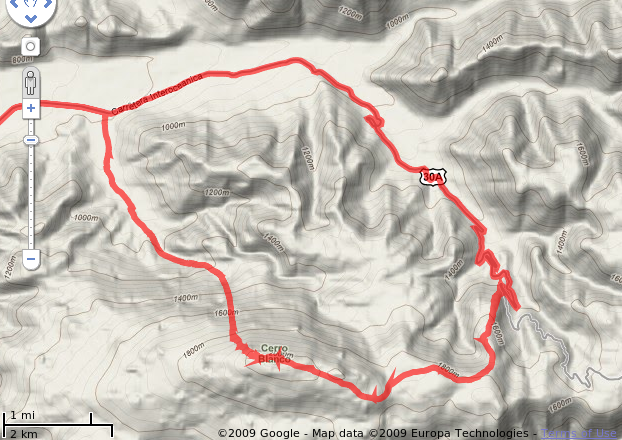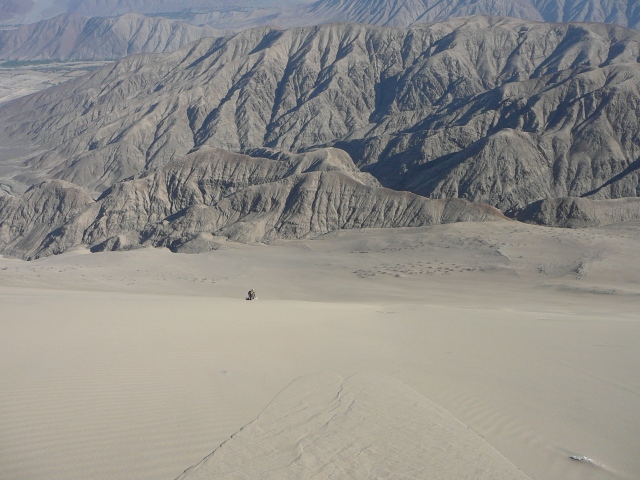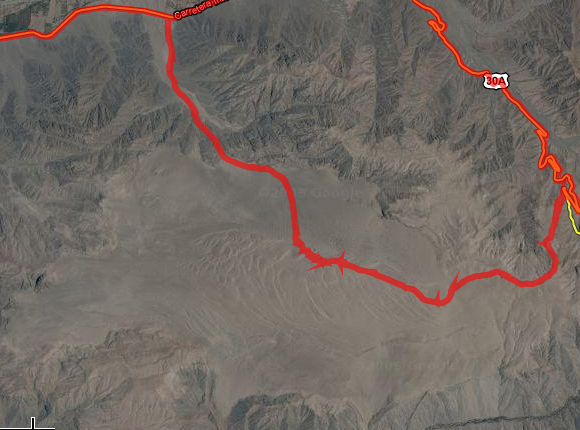
Cerro Blanco (white mountain) close to Nazca, Peru is the highest sand dune in the world (according to Wikipedia: height from base: 1176m, height from sea level: 2080m; according to Nazca tour operators the hight from sea level is 2072m). The longest sandboardable slope offers altitude change of some 700 meters (rough estimate based on my GPS). (Note that in Namibia, at Sesriem, the highest dunes were 300m, the people there called them the highest in the world, which seems to be nonsense.) It is surrounded by rock mountains, unclear how the sand got blown here.
Arranging the Cerro Blanco hike/sandboarding trip in Nazca can be time-consuming and confusing. The following text was written to document in a detailed way one particular Cerro Blanco hike (which took place on 2010-01-31), so one knows roughly what to expect.
Nazca doesn't have a vibrant sandboarding scene with shops selling T-shirts and hoodies with pictures of the highest sand-slope in the world on them. Nevertheless every tour agency offers sandboarding on Cerro Blanco as one of the activities next to viewing the Nazca lines. The cost of the trip is 35–45 USD per person and includes pick-up from the hotel, some fruits, a sandboard and an English-speaking guide. When it comes to selling the trip the tour agencies first call Enrique Tomairo (see: http://sandboardtomairo.blogspot.com) and if he is not picking up, then they ask you to come back later — Enrique seems to be pretty much the only sandboarding guide in Nazca, there are a few more, but not all companies know their phone-numbers or are otherwise reluctant to call them.
The agencies are also badly informed about other aspects of the trip:
Of course, being salespeople, they don't show that they have no idea how the trip actually works and act confident spreading false information. The only way to find out that they don't know much is to talk to many of them and observe that the information given is conflicting.
Pick up from a hotel in the center of Nazca at 3am. The car takes you to 23km along the road to Cusco and drops you at the trail head (at 3.30am). The altitude here is 1400m [BUG: check] (Nazca is at approx. 600m.) It's quite dark even though it's full moon. The guide (forgot the name, not Enrique) has a flashlight but for us it's useless but fortunately we have our head-torches. The first part of the climb is steep over sharp rocks. Reach a flatter part after 50minutes of walking, 4.20. The sand dune is now visible, although not the top of it. Now there is more light (from the moon) one can even walk without the torches, although not all the time. After a while reach a place where local people make offerings to the gods who live on Cerro Blanco. There is a circular fireplace-like stone arrangement on the ground, filled with orange peels. Our guide puts some dry coca leaves to the middle of the "fireplace". He apologizes that he doesn't speak any Quechua thus cannot say the chant.
The sun is rising (5.50am) there is a lot light now and starts to get hot. Maybe it would have been better to leave at 2am as the tour company suggested. After a while we reach the dune, the climbing gets very difficult here as the surface is soft. Fortunately there is not much to climb anymore, we already reach the top (at 6.20am, after 2h50min of climbing). There are little dunes everywhere, and further away the rocky mountains. For a remote place like this, there is a lot of garbage everywhere. Are these plastic bags and bottles an offering to the local gods, or the local people don't really care about the beauty of their mountain?

Have some buns with water, and a few bananas and apples that the tour company has provided. Now comes practice time. We wax the boards with a candle and ride down a small slope. It doesn't seem possible to turn with these boards. The boards are 1.5cm thick, completely symmetrical, i.e. there is no front or back, the bindings are simple straps arranged so that your feet are parallel. Ride down the slope 3 times, climbing up again is exhausting. Then rest a bit and start descending.
There are some longer slopes where we try to sandboard but it doesn't really work out. The board hardly slides (one needs to wax it very frequently). Don't know if this is the property of the board or the sand. I don't really feel comfortable with the (small) board and the riding technique. It's much easier to just sledge down the slope, so I switch to sledging.

After some 15 minutes of descending we reach the final slope. It's huge. From the top the path below that will take us to the road is barely visible. The slope is quite steep and very wide. I sledge down half of the slope and then get stuck, waxing helps it maybe 20m further, but it's a hassle, so I just walk.

The dune is the white area in the middle of the dark sharp peaks. On the right side the Nazca-Cusco road that leads to the trail-head is visible.
The final walk to the car is over rocks, through dry riverbeds, next to a huge cactus field.
Back in Nazca a bit before 10am, so that we still made it to our hotel's free breakfast (coffee or tea + some days old buns with jam). So the whole trip was 7 hours.
Positive: nice views from the world's largest sand dune; sledging down a slope which seemed to go on forever.
Negative: arranging the trip took a whole afternoon, the sandboarding aspect of the trip sucked.